This was published 3 years ago
Radioactive: Inside the top-secret AUKUS subs deal
Secret meetings and subterfuge over many months shored up Australia’s “40-year fantasy” of a mighty nuclear marriage with the US and the UK.
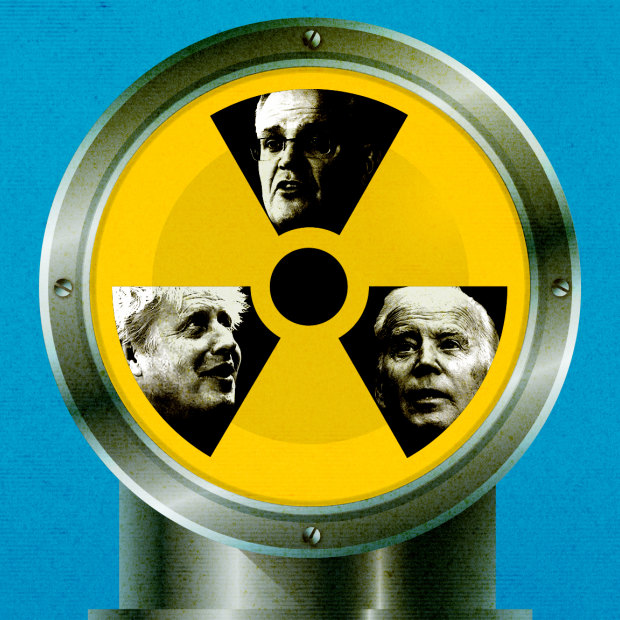
Prime Minister Scott Morrison, US President Joe Biden and British PM Boris Johnson were the three signatories to the AUKUS agreement.Credit: Richard Giliberto
When Joe Biden was first briefed on Australia’s request for nuclear-powered submarines, he did not say “yes”. He was cautious, even sceptical. Among his doubts was whether Australia was up to it.
In the meeting with about a dozen of his top national security officials in a secure White House situation room, the US president remarked that while Australia was a stalwart ally, this was an enormously complex and expensive undertaking.
“He asked lots of questions,” said the official who led the briefing, the Indo-Pacific Co-ordinator in Biden’s National Security Council, Kurt Campbell. “He wanted to be convinced.”
The Australians were asking for the crown jewels in the national security vault, one of America’s remaining decisive advantages over China. The US had shared its nuclear sub secrets with only one nation, Britain, in 1958. Much had changed since.
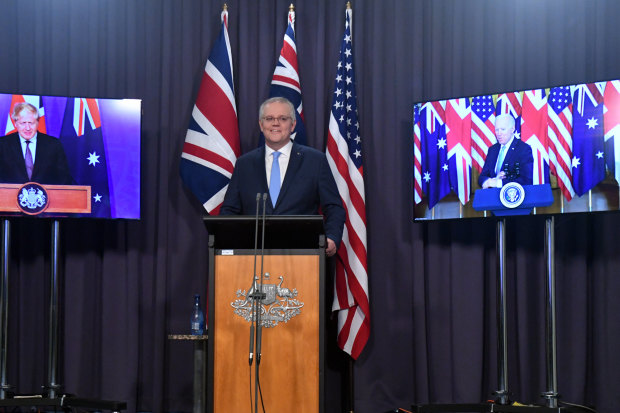
AUKUS announcement: Scott Morrison at the virtual joint press conference with British Prime Minister Boris Johnson and US President Joe Biden.Credit: AAP
The transformational power of nuclear-propelled subs is that they could allow Australia to pose a direct threat to the Chinese mainland. For the first time. It had come to that.
With unlimited range because they never need to refuel, and with vertical launch tubes for firing missiles, a nuclear-propelled submarine could stand off China’s coast and threaten it with cruise missiles.
Australia’s existing fleet of submarines, the six diesel-powered Collins class, is equipped with torpedo tubes only. Which means it can fire torpedoes at targets in the water but not missiles at targets on land.
But it had been a 40-year fantasy of Australian governments to get American nuclear propulsion. Canberra had been turned down every time. Indeed, no earlier request had even reached the president’s desk. The US Nuclear Navy, guardians of the technology, had ruled it out of the question.
Now the Australian appeal had the president’s full attention. The briefing paper in front of him ran through the positives and negatives of such an arrangement –it did not contain a recommendation.
On the positive side of the ledger, the top consideration was that it would help counter China. The People’s Liberation Army Navy has the advantage over the US in warfighting on and above the ocean. Arming an ally with nuclear-powered subs would help blunt China’s edge.
Nuclear-propelled submarines “are fast, they have stamina, they bring a whole spectrum of weapons, and if you are China, how are Australian and US forces working together?” poses the former chief of US Naval Operations, retired Admiral Jonathan Greenert.
“You don’t know their sovereign decisions. Your imagination is your biggest nightmare – what could they be doing? They can reposition fast, 25 knots [46km/h] for a full day. If an adversary says, ‘I’ve got a detection of a nuclear sub’, great – when? Two days ago. Then you draw a circle on the map and see where it might be. It’s a big circle.”
The US today has 68 submarines, all nuclear-powered. China has an estimated 76 subs, of which 12 are nuclear-powered. But the US fleet is shrinking as it retires older subs faster than it can build new ones. China’s nuclear-powered fleet is expanding. The AUKUS agreement aims to help Australia acquire eight.
Second, it would cement the alliance with Australia. Just a few years earlier, many in the US foreign policy community including Campbell had tipped Australia to be the ally most vulnerable to China’s influence, that it would “flip” and align with Beijing.
Instead, Australia had “set an incredibly powerful example” for the world in standing up to China, as Secretary of State Antony Blinken said in an interview this year. A nuclear subs deal would lock Australia more tightly into the US bloc.
Third, it would help the US to deter China’s expansion through the Indo-Pacific. It would signal US commitment to the region and to US allies, reassuring other Indo-Pacific nations who might be doubting American staying power. “The president said, ‘this could be quite powerful’,” according to an official who was present.
But on the other side of the ledger, Biden himself raised four big concerns with the Australian request. First was nuclear proliferation. Since the deal with Britain in 1958, Washington, London and Canberra, among others, had signed the Nuclear Non-Proliferation Treaty. If we give the Australians this technology, won’t we be in breach of the treaty, Biden wanted to know?
Second was the response from China. How will Beijing react if we agree to this? Will it provoke Xi Jinping into accelerating his own naval build-up, into getting more aggressive?
Third was Australia’s capability. Would the Australian political system be capable of bipartisan commitment for the decades required? Is Australian politics stable enough? Could Australia afford the price tag?
Fourth, would the US Nuclear Navy be prepared to deliver? This had been the obstacle to every other Australian inquiry. This elite priesthood is the guardian of the fast, stealthy, underwater Doomsday machines that are America’s last line of defence.
America’s nuclear warfighting is structured on a “triad” - ground-based, airborne and undersea forces. The ground-based and airborne forces are the most vulnerable to enemy attack. But even if these are destroyed in a surprise first strike by an enemy, its nuclear-powered, nuclear-armed subs are designed to survive, undetected in the dark depths, to deliver annihilation to the enemy. By guaranteeing “second strike” capability, they deter any adversary from even thinking about launching a first.
Australia was not asking for nuclear weapons; it was content to arm its subs with conventional missiles. And Canberra was not so much concerned about nuclear Armageddon. Australia has entrusted that responsibility to the US, sheltering under America’s nuclear “umbrella”. Australia was feeling threatened by China and wanted the capacity to threaten it in return.
As the discussion around the White House table unfolded last year, other concerns emerged. The group included Secretary of State Blinken, Defence Secretary Lloyd Austin, National Security Adviser Jake Sullivan, and the chairman of the Joint Chiefs, General Mark Milley.
What if we attempt this three-way agreement with Australia and Britain and it fails? The credibility of all three nations would be damaged. Have the Australians consulted fully with the French about their contract? Do we risk alienating one ally to gratify another?
The meeting broke up without a decision and with big questions needing to be answered. In the meantime, Australia had a contract with Paris – and French President Emmanuel Macron was deeply invested in it.
“Ambition”. That was the one-word brief that Macron personally gave his ambassador to Australia, Jean-Pierre Thébault, when he sent him to Canberra in 2020. The president urged his ambassador to be ambitious and imaginative in expanding the relationship. The submarines were to be the strategic anchor, evidence of shared commitment to a free and open Indo-Pacific, which is code for resisting China’s expansionism.
Macron thoroughly charmed Australia’s previous defence minister, Linda Reynolds, for instance. He made sure she was invited to the launch of the first of France’s newest class of nuclear-powered submarines, the Barracuda, in the Normandy seaside city of Cherbourg, in 2019. He arranged for her to tour the sub’s interior, which she found impressively spacious, with no head-ducking required.
As Macron pressed a ceremonial launch lever, it illuminated a video art installation designed to evoke the sights and sounds of the ocean along the sub’s sides. “You,” Macron addressed the workers who’d built the boat, “are building the independence of France. It’s our very status as a great global power.”
L’Express newspaper had hailed Australia’s order for 12 diesel-powered French submarines, nicknamed the shortfin Barracuda and also known as the Attack Class, as “the contract of the century”. Malcolm Turnbull’s government had put the deal in place and in February 2019 while Scott Morrison presided over the formal signing of the Strategic Partnering Agreement to allow it to proceed.
In France, national pride and national honour were engaged, not to mention French economics – it was the biggest defence export contract France had signed, and the biggest Australian acquisition. The contract value was $50 billion but adjustments for inflation and extras took the total deal to at least $90 billion.
Macron’s charm soon wore off. Reynolds found herself in a ritual quarterly exchange with her French counterpart, Florence Parly. “She’d begin each meeting by telling me what her department had told her. Then I’d have to tell her, no, this is the situation, and I’d start unpacking it,” Reynolds told colleagues.
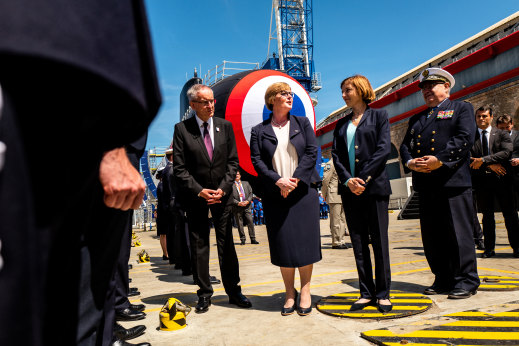
Thoroughly charmed: French President Emmanuel Macron made sure then defence minister Linda Reynolds, seen here with her French counterpart Florence Parly, was invited to the launch of the first of France’s newest class of nuclear-powered submarines, the Barracuda, in Cherbourg in 2019. Credit: Abaca
This was the frustration phase of the contract with the builder, Naval Group, the new name for the state-owned shipbuilder founded four centuries ago by the famed strategist and prime minister, Cardinal Richelieu, who, incidentally, was the inventor of the table knife. He wanted France to muscle up to English naval power and the enterprise was born.
But in early 2020, only a year after the deal was signed, the Australian National Audit Office reported that the design phase was running nine months late. It could not verify that the initial outlay of nearly $400 million had been spent effectively, it said. And it revealed that the government’s expert submarine advisory group had questioned the viability of the whole plan at its very earliest phase.
“Alarm bells are ringing,” said the only former submariner in parliament, South Australia’s independent Senator Rex Patrick. The government, he said, should consider a Plan B.
Reynolds defended the French deal in public: “The first Attack Class submarine is scheduled for delivery to the Royal Australian Navy in 2032. The Australian National Audit Office report confirmed there has been no change to this delivery timeframe or budget.”
But in private Reynolds agreed with Patrick and the other sceptics: French Defence Minister Florence Parly “was working with us in good faith, but I started to discuss with the PM, ‘is there an alternative if this falls over’?”
Within six months of winning the May 2019 election, Scott Morrison was worried enough to tell Macron personally of his growing concerns. He was frustrated with the time it was taking, the difficulties with design and the lack of responsiveness. Morrison relayed this to Macron, who replied: “Keep me informed.”
Towards the end of 2019, Morrison started to ask his closest advisers about fallback options, including nuclear-propelled ones. They told him of the joyless history of Australian requests for nuclear propulsion and that the likelihood of getting the technology from the US or Britain was “very, very low”. And they warned him that Australia would need a civil nuclear industry. Without one, it couldn’t maintain the nuclear reactors that drive the boats. On March 19, 2020, two months after the Audit Office report, the prime minister took the first formal step towards exploring contingencies.
Secretly, he asked the secretary of the Defence Department, Greg Moriarty, for a discussion paper about all the options, including nuclear-propelled ones. He had the result within a fortnight.
The next month, Macron replaced the global chief executive of Naval Group, a step applauded in Canberra. The new boss, Pierre Eric Pommellet, was considered more amenable to Australia’s concerns. The prime minister felt encouraged that Macron was making an effort to get the deal back on track.
Morrison decided to take the next step regardless. In May, 2020, he asked Moriarty and the military co-leader of the Defence Department, Chief of the Defence Force, General Angus Campbell, to form a small, expert group to see whether it was feasible for Australia to acquire and operate nuclear-powered subs. The top-secret exercise was led by the Chief of Navy, Vice Admiral Michael Noonan.
It came back with the conclusion that it was potentially feasible, but on two conditions. One, it was only possible with the help of the US, Britain or both. This was the only way Australia could operate nuclear-powered subs without setting up a civil nuclear industry to support them.
America and Britain use highly enriched, weapons-grade uranium to run their subs’ reactors. That means the reactors don’t need refuelling for the life of the boat itself, some 30 years.
Two, the same consideration ruled out the French nuclear-propelled sub, the big Barracudas Macron had launched so proudly, as an option. The French use low-enriched uranium, meaning their reactors need to be refuelled every decade or so in a lengthy process called full-cycle docking. This would keep the Australian fleet permanently dependent on Paris.
Moriarty’s opinion was that this would not be a sovereign Australian capability. Unless Australia started its own civil nuclear industry to refuel and maintain the reactors, something which Morrison would not countenance.
Tantalised, Morrison immediately asked Defence to contact the Pentagon to test its assumptions. Through a series of secure video conferences between the Pentagon and Defence’s headquarters on Russell Hill, the US Navy gave a guarded endorsement, summarised by an Australian official: “There’s nothing in your thinking that’s completely implausible”. But there was no enthusiasm from the Americans and certainly no commitment to help.
For the prime minister, this was a “game changer” nonetheless, as he’s described it to colleagues. The revelation: It was possible to have a nuclear-powered attack submarine, or SSN as navies call it, without needing to service the reactor.
To now, Morrison had briefed only two members of his cabinet, Linda Reynolds and the Foreign Affairs Minister, Marise Payne. But now that he envisaged raising the idea with the American president and British Prime Minister Boris Johnson, he decided to widen the circle.
When he briefed Treasurer Josh Frydenberg, he met an enthusiastic response. He remarked that the politics in the three capitals of Washington, London and Canberra seemed to be in alignment. “You could never do this deal with (the former leader of British Labour) Jeremy Corbyn,” said Frydenberg. “When a gate like this opens, you go through it.”
But what of the multibillion-dollar cost of cancelling the French deal and the far greater cost of building SSNs? “Everything is affordable if it’s a priority,” was the treasurer’s attitude. “This is a priority.”
Morrison then took it to the National Security Committee of his cabinet. This is the overarching mechanism for co-ordinating defence and security and includes top officials and ministers responsible for defence, foreign affairs, home affairs and intelligence. It gave Morrison the green light to take it further. “It was a high level of secrecy because there was no guarantee we could pull it off,” Morrison told colleagues. He didn’t want to disrupt progress with the French toward a conventional sub in case he failed with the Anglo American nuclear option, and end up with neither.
Morrison kept it so tight that the PM’s personal permission was required before any official could be brought into the charmed circle, a top civil servant explained. “So if anything leaked, you knew you’d be personally accountable to the PM himself,” said the official.
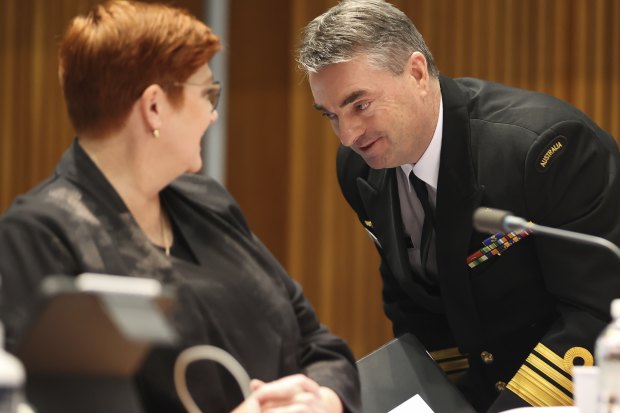
Minister for Foreign Affairs Marise Payne and Rear-Admiral Jonathan Mead during a Senate estimates hearing. Mead was a crucial choice to lead the pursuit of SSNs.Credit: Alex Ellinghausen
Donald Trump lost the US election around this time. Morrison decided it was pointless to approach the outgoing president, but he would pursue the incoming one at the first opportunity.
In the meantime, Morrison wanted to see what the Brits might be able to offer. In February 2021, Defence made contact with Whitehall. The British Navy was encouraging but non-committal.
In the same month, Linda Reynolds instructed the ADF’s General Campbell to advise the government on how to give Australia strike power. It was part of the government’s awakening to Australia’s strategic puniness against its great rival, China.
Australia then, and now, had no long-range strike capability whatsoever. None on land, none in the air force, none in the navy. The ADF was set up for counterinsurgency wars as part of a US alliance like those in Afghanistan and Iraq, and low-level conflict in the Pacific Islands like the missions in East Timor and the Solomons, but was unprepared for high-intensity warfighting with a capable nation state.
Reynolds tasked the Capability Enhancement Review with recommending the strike power Australia needed. One part was to be the nuclear subs project. Campbell made a crucial choice by appointing Rear Admiral Jonathan Mead, a one-time clearance diver with a PhD on Indonesia and merit awards for skippering 186 Persian Gulf boardings in six months of the Iraq war in 2005, to lead the pursuit of SSNs.
Eventually, the moment arrived for Australia’s first approach to the Biden White House. Mid-pandemic, there had been very few openings to allow travel between Canberra and Washington. And this proposal was considered too sensitive for anything but face-to-face discussion.
In May 2021, the moment came. The director-general of Australia’s peak intelligence assessment agency, the Office of National Intelligence, Andrew Shearer, was planning a routine visit to Washington to consult with his US counterparts. He’d been briefed on the nuclear subs project. Would you like me to broach it with the White House, he asked the prime minister? Morrison agreed. Shearer managed to sidestep the Russian roulette of Australia’s vaccine rollout with the help of doctors at the Department of Foreign Affairs and Trade.
When the softly spoken Australian spy walked into the West Wing of the White House, his American interlocutors knew only that he wanted to discuss a matter of “the utmost sensitivity”. He walked into the ornate, chandeliered office of the National Security Adviser, Jake Sullivan, with only one other person present, Kurt Campbell, one of Sullivan’s senior staff and Biden’s Indo-Pacific co-ordinator.
Shearer and Campbell had known each other for decades. He explained what Australia wanted. “As China’s capability advances, we need to have submarines capable of meeting it. We need to be able to operate without the risk of easy detection by the Chinese,” Shearer said, according to the participants.
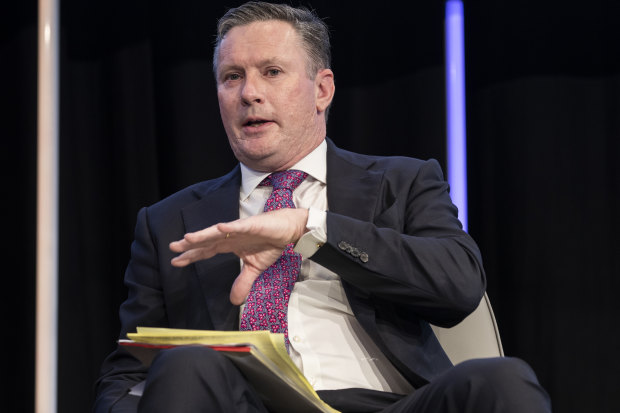
Top spy: National intelligence chief Andrew Shearer broached the plan with the White House in April 2021.Credit: Louie Douvis
Shearer told the Americans that the Coalition government had chosen the French diesel-powered option when it expected to be contesting the waters in its near neighbourhood and dealing with low-level threats. But “the security circumstances have changed dramatically and the only way we can remain strategically relevant in highly contested circumstances is if we have the ability to launch cruise missiles over long distances”.
My sources didn’t put it quite this bluntly, but everyone in the room understood that this was about Australia acquiring the power to pose a direct threat to China’s forces and the Chinese mainland.
Sullivan and Campbell immediately were interested. Biden has described the US rivalry with China as “the competition for the 21st century”. With this request, Australia was choosing sides emphatically.
Campbell told me afterwards: “What most countries do when grappling with relevance, when risks and costs are enormous, is they just opt out. Australia chose relevance.” It was “a bold and important idea”.
Shearer emphasised that Australia had no intention of developing a civil nuclear industry or developing nuclear weapons. He said that Canberra was satisfied it could operate the subs while preserving Australia’s strong record on nuclear non-proliferation.
Sullivan and Campbell had lots of questions about Australian technological, personnel and financial capacity but the potential killer at this threshold meeting was Australian politics. “We asked lots of questions about politics,” said Campbell. “Would this be contentious? Would this hold?”
Bipartisan political commitment, Labor and Liberal, was a prerequisite, the Americans said. “This would be a military marriage. It would have to hold over decades.”

President Joe Biden in the State Dining Room of the White House in April last year with (from left) his Secretary of State Antony Blinken, National Security Adviser Jake Sullivan, Treasury Secretary Janet Yellen and Kurt Campbell, coordinator for the Indo-Pacific on the National Security Council.Credit: AP
Shearer’s reply was that, though the government hadn’t had the conversation with Labor, “public debate about the threat had changed significantly and there was a pretty strong bipartisan agreement with the Left on the security environment in Australia”.
At the close of the meeting, Sullivan told Shearer that “this will be looked at very seriously over months, not years, and we’ll try to cut through the bureaucracy”.
Shearer didn’t trust even secure communications channels to tell Morrison about the meeting, only sending him an oblique message that “the proposition had been well-received”. But when Shearer returned to Canberra he made clear to Morrison and his other colleagues that the White House had set political bipartisanship as a non-negotiable condition. “If Albo says ‘no’, the deal will be dead,” as Australia’s ambassador to Washington, Arthur Sinodinos, put it to colleagues.
The White House trusted Morrison to bring Labor in on the secret and the US made no approaches, formal or otherwise, to test Labor’s reaction. Yet the prime minister decided not to brief Labor leader Anthony Albanese for five months. He briefed him on the day before the deal was to be announced in a three-way piece of theatre with Morrison, Prime Minister Johnson and President Biden. It was high stakes on a very tight deadline.
This is part one of a two-part series by Peter Hartcher examining the AUKUS deal. Read part two here.
Cut through the noise of the federal election campaign with news, views and expert analysis from Jacqueline Maley. Sign up to our Australia Votes 2022 newsletter here.